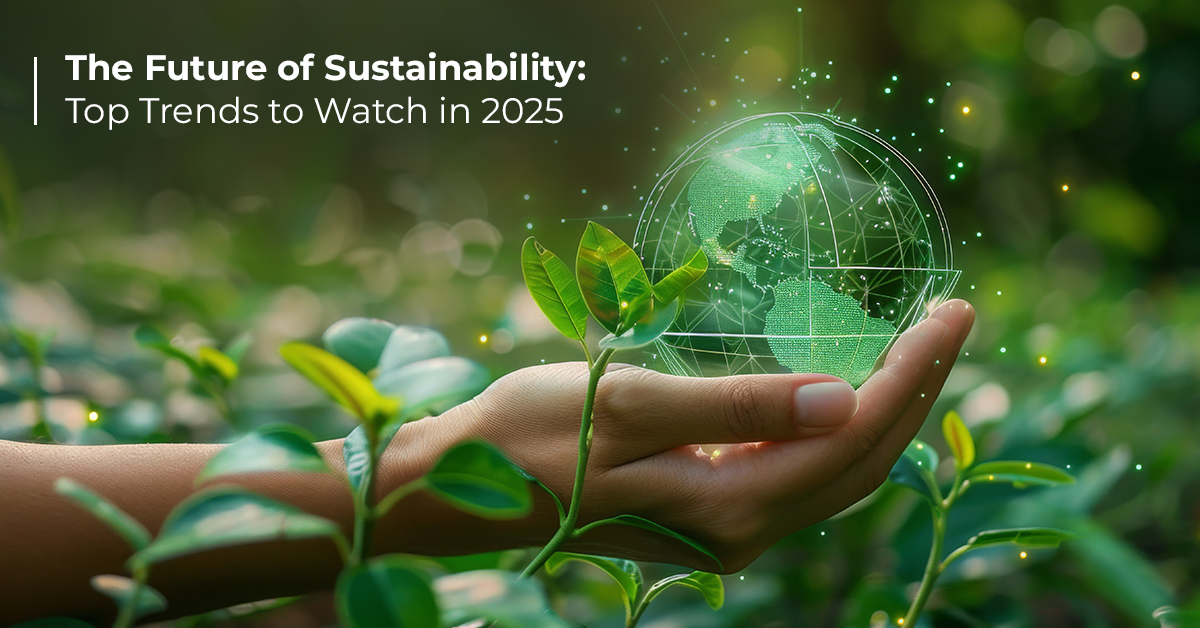Sustainability has become more than a buzzword; it is now a necessity. The year 2025 promises to redefine how we think about environmental responsibility, business practices, and individual actions. As climate change impacts become more evident, the urgency for sustainable practices has reached an all-time high.
In this blog, we will explore the key trends shaping the future of sustainability in 2025. From groundbreaking technologies to social movements, let’s dive into what the future holds.
The Rising Importance of Sustainability in 2025
The importance of sustainability or sustainable development is on the rise. According to the United Nations, over 80% of global companies now incorporate sustainability into their business models. Additionally, studies show that 80% of consumers are willing to pay more for sustainable products.
This growing awareness is fuelled by environmental degradation, resource scarcity, and global initiatives such as the Paris Agreement. In 2025, sustainability will play a vital role in shaping industries, governments, and individual lifestyles. It’s a pivotal year for accelerating progress toward a greener planet.
Key Drivers of Sustainability Trends in 2025
Several factors are driving sustainability trends in 2025. These include:
- Technological Innovations: Advanced technologies like AI, IoT, and blockchain are streamlining sustainable practices.
- Consumer Awareness: More consumers demand eco-friendly products and services.
- Government Policies: Stricter environmental regulations are forcing industries to adapt.
- Corporate Responsibility: Businesses are adopting sustainability to stay competitive and meet stakeholder expectations.
- Global Collaboration: International partnerships are fostering collective efforts toward sustainability goals.
What is the Future of Sustainability: Top Sustainability Trends to Watch in 2025
Sustainability trends in 2025 will reshape how we live and work. Let’s explore the top sustainability industry trends:
1. Green Energy Revolution
Renewable energy sources like solar, wind, and hydrogen are becoming mainstream. Governments worldwide are increasing investments in clean energy infrastructure. In 2025, innovations like floating solar farms and advanced wind turbines will enhance efficiency and accessibility.
2. Circular Economy Practices
The linear “take-make-dispose” model is being replaced by circular economies. Recycling, reusing, and upcycling are driving industries toward zero-waste models. Circular economies are particularly gaining traction in sectors like fashion, technology, and construction.
3. Smart Cities and Urban Sustainability
Cities are embracing smart technology to enhance sustainability. From energy-efficient buildings to AI-managed traffic systems, urban areas are becoming greener. By 2025, smart cities will contribute significantly to reducing carbon footprints.
4. Sustainable Agriculture
With food security challenges on the rise, sustainable agriculture is critical. Innovations such as vertical farming, precision agriculture, and plant-based proteins are gaining momentum. These practices ensure environmental conservation while meeting global food demands.
5. Eco-Friendly Transportation
Electric vehicles (EVs) are no longer a luxury but a necessity. Public transportation is also undergoing eco-friendly transformations, with hydrogen-powered buses and shared mobility platforms gaining popularity.
6. Social Sustainability
Diversity, equity, and inclusion are being recognized as integral to sustainability. Companies and governments are investing in social sustainability programs that prioritize fair labor practices, gender equality, and community welfare.
The Role of Businesses in Sustainability in 2025
Businesses will play a crucial role in driving sustainability in 2025. Here’s how they contribute:
- Adopting Renewable Energy: Transitioning to solar, wind, and other renewable sources.
- Reducing Carbon Footprint: Implementing energy-efficient operations and logistics.
- Promoting Green Products: Offering eco-friendly alternatives to traditional products.
- Building Ethical Supply Chains: Ensuring responsible sourcing and labor practices.
- Collaborating for Change: Partnering with NGOs and governments on sustainability initiatives.
Related Blog: Building a Greener Tomorrow: The Role of Women in Sustainability
H2: Challenges in Achieving Sustainability in 2025
Despite progress, challenges remain in the path to sustainability. These include:
- High Initial Costs: Investments in green technologies can be expensive.
- Resistance to Change: Industries and consumers may hesitate to adopt sustainable practices.
- Limited Awareness: Many still lack knowledge about sustainability’s benefits.
- Infrastructure Gaps: Inadequate facilities for renewable energy and waste management.
- Policy Inconsistencies: Variations in regulations across regions create obstacles.
- Resource Scarcity: Limited availability of critical resources like water and minerals.
FAQs about Future of Sustainability
Q1. What is the biggest sustainability trend in 2025?
The green energy revolution stands out as the most significant trend. Renewable energy sources, particularly solar and hydrogen, are expected to dominate energy production. Technological advancements are making these solutions more accessible and affordable, driving global adoption.
Q2. How can individuals contribute to sustainability?
Individuals can make a difference by adopting eco-friendly lifestyles. Actions such as using public transport, reducing single-use plastics, and supporting sustainable brands can have a significant impact. Small steps collectively lead to substantial change.
Q3. Will renewable energy be more affordable in 2025?
Yes, renewable energy is becoming increasingly cost-effective. Innovations in solar panels, wind turbines, and battery storage are reducing costs. Governments are also providing subsidies and incentives to encourage adoption.
Q4. How do sustainability trends impact the economy?
Sustainability trends create new economic opportunities. Industries like renewable energy, green tech, and eco-tourism are experiencing rapid growth. Sustainable practices also lead to cost savings and improved brand reputation for businesses.
Q5. What industries will see the most growth in sustainability practices by 2025?
Industries such as renewable energy, agriculture, technology, and transportation are expected to lead sustainability efforts. Sectors like fashion and construction are also adopting eco-friendly practices to meet consumer demand and regulatory requirements.
Conclusion
The future of sustainability in 2025 is both promising and challenging. While advancements in technology and awareness are driving progress, overcoming obstacles requires collective effort. From governments and businesses to individuals, everyone has a role to play.
By embracing these trends and addressing sustainability challenges, we can move closer to a greener, more sustainable world.
Be the Change: Lead the Way in Sustainability Efforts
Sustainability starts with you. Small actions can lead to significant impacts. Support green initiatives, reduce waste, and advocate for eco-friendly practices. Together, we can create a future that is not only sustainable but also thriving.
Visit Prabhu Naidu Ltd and learn more about how we’re driving women’s empowerment through eco-friendly sustainable practices.


